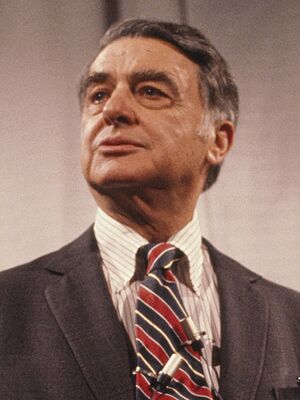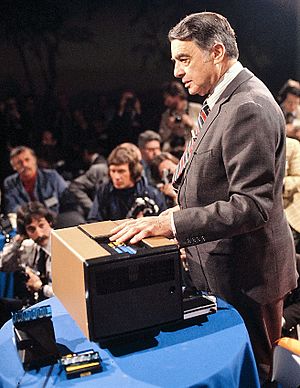Edwin H. Land facts for kids
Quick facts for kids
Edwin H. Land
|
|
|---|---|

Land in 1971
|
|
| Born |
Edwin Herbert Land
May 7, 1909 |
| Died | March 1, 1991 (aged 81) |
| Resting place | Mount Auburn Cemetery |
| Other names | Dr. Land, Din (close friends) |
| Known for |
|
| Spouse(s) | Helen "Terre" Maislen (m. 1929; 2 children) |
| Awards |
|
| Scientific career | |
| Fields | Optics, polarization, color vision |
Edwin Herbert Land (May 7, 1909 – March 1, 1991) was an amazing American scientist and inventor. He is best known as the co-founder of the Polaroid Corporation. He invented many things, including special filters for light, the first instant camera, and a theory about how we see colors.
His famous Polaroid instant camera came out in 1948. It allowed people to take a picture and have it developed in less than a minute!
Contents
Life and Discoveries
Edwin Land was born in Bridgeport, Connecticut. Even as a kid, he loved to take things apart to see how they worked. He once took apart a clock and his family's new record player! His older sister called him "Din," and that nickname stuck with his close friends.
He went to high school at Norwich Free Academy and graduated with honors. Later, he studied physics at Harvard College. But he left after his first year to move to New York City.
Even without a proper lab, he invented the first inexpensive filters that could polarize light. He called this "Polaroid film." He would sneak into a lab at Columbia University late at night to use their equipment. He also read many science books at the New York Public Library. His big idea was to make a film with millions of tiny crystals that all lined up perfectly.
Land went back to Harvard but never finished his degree. Still, many people called him "Dr. Land" because of his amazing scientific work. His wife, Terre, often helped him write down his ideas for homework.
Starting Polaroid
In 1932, Edwin Land started a company called Land-Wheelwright Laboratories with his Harvard professor, George Wheelwright III. They wanted to sell his new polarizing technology.
The company later changed its name to the Polaroid Corporation in 1937.
Polaroid film was first used for sunglasses and scientific tools. But it quickly found many other uses! It was used in Wurlitzer jukeboxes for cool color effects. It also helped create glasses for 3-D movies and is a key part of all LCD screens today.
During World War II, Land helped the military. He developed special goggles and a viewing system called the Vectograph. This system helped pilots see camouflaged enemy positions in photos.
The Instant Camera Idea
The idea for the instant camera came to Land while he was on vacation in New Mexico. His three-year-old daughter, Jennifer, asked why she couldn't see the picture he had just taken of her right away. Within an hour, he had the idea for an instant film camera!
Just over three years later, in 1947, Land showed off his instant camera and film. It was called the Land Camera. It went on sale less than two years later. The first 57 cameras and all the film sold out on the very first day!
Edwin Land was known for working very long hours. When he had an idea, he would work on it until the problem was solved, sometimes without breaks. He even wore the same clothes for 18 days straight once! As Polaroid grew, he had teams of assistants working with him in shifts.
Elkan Blout, a close friend and colleague, said Land was a "true visionary." He saw things differently and was a brilliant, driven man.
Helping with Spy Technology
After World War II, Land played a big part in developing ways to gather information using photos. He helped design the optics for the Lockheed U-2 spy plane. He also contributed to satellite programs like Corona. He often advised President Dwight D. Eisenhower on these important matters.
Later Years and Legacy
In the 1950s, Land discovered a way to project a full range of colors using only two colors of light. This work later became part of his Retinex theory of color vision, which explains how our brains see colors.
In 1957, Harvard University gave him an honorary doctorate. A street in Cambridge, Massachusetts, is named Edwin H. Land Blvd. in his honor.
In the 1970s, Land developed the Polaroid SX-70 camera and film. He considered this instant color photography system his greatest achievement.
Even though he was the head of Polaroid, Land always thought of himself as a scientist first. He made sure to do "an experiment each day." He also believed in fairness. He hired women as research scientists from the start. After the assassination of Martin Luther King Jr. in 1968, he made Polaroid a leader in the affirmative action movement, which aimed to create equal opportunities for everyone.
Land also loved art. He built giant cameras that produced huge prints. He let famous photographers like Ansel Adams and Andy Warhol use these cameras for free. In return, he kept some of their amazing photos for the Polaroid Collection. This collection grew to tens of thousands of photos by great artists.
Land resigned from his role as an advisor to the President during the Watergate scandal in 1973.
His Polavision instant movie system was not a success, and he resigned as Chairman of Polaroid in 1982. By the time he retired, he had 535 patents! Only Thomas Edison had more. Even in retirement, he kept working on his research into color vision. He founded the Rowland Institute for Science to continue his scientific work.
Death
Edwin Land passed away on March 1, 1991, at age 81. His family chose not to share the cause of his death. Land didn't want people to focus on his personal life, but rather on his scientific work. So, after he died, his family had a lab assistant shred his personal papers and notes.
He is buried in Mount Auburn Cemetery in Cambridge, Massachusetts.
Awards and Recognition
Edwin Land received many honors for his incredible work:
- He was awarded the Presidential Medal of Freedom in 1963, which is the highest award for a U.S. citizen.
- He received the National Medal of Technology in 1988 for inventing instant photography.
- He was inducted into the National Inventors Hall of Fame in 1977.
- Even without a formal college degree, he received honorary degrees from many top universities like Harvard University and Yale University.
- He held 535 patents, which shows how many things he invented!
- His invention of instant photography was named a National Historic Chemical Landmark in 2015.
- He is even referenced in a Lego set based on the Polaroid OneStep SX-70 Camera!
See also
 In Spanish: Edwin Herbert Land para niños
In Spanish: Edwin Herbert Land para niños


